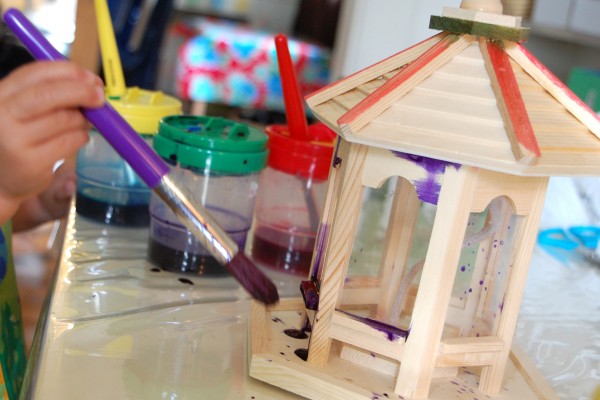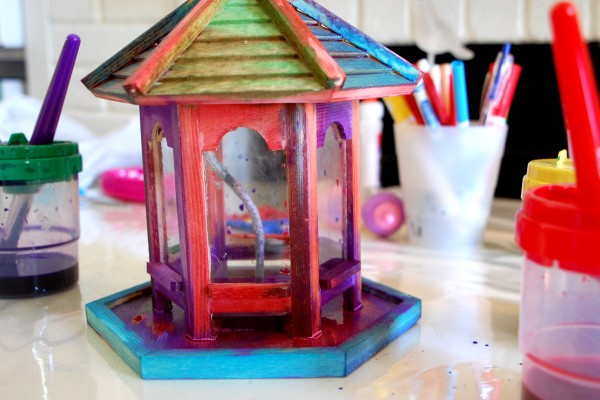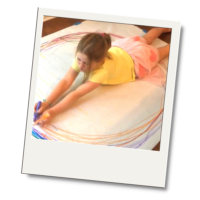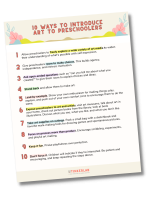“I think, at a child’s birth, if a mother could ask a fairy godmother to endow it with the most useful gift, that gift should be curiosity.” – Eleanor Roosevelt

I really wanted a birdhouse. I’m not sure why exactly, but I impulsively and enthusiastically bought an unfinished birdhouse, and for whatever other reason, I then tucked it away in the back of closet. The mind works in odd ways.
In any case, about a week ago, my daughter became especially fascinated by some birds she saw on one of our walks. The observation led to further curiosities about birds in our books, birdhouses, naming birds in various toys, and spotting birds in the sky. Following one of our bird chats, I offered up that we could make our very own birdhouse. What I didn’t completely anticipate was the unbounded enthusiasm you often see when someone has earned an Olympic gold medal! And what I experienced in that short, beautiful moment is that my child was thrilled that I had not only listened to her, but that I also intended to help her pursue her interests and follow her curiosities.
 Seeing the enthusiasm, I quickly pulled out the birdhouse, paint, and brushes. I’ve been unprepared for these impulsive moments in the past, and was relieved that the table was already covered in vinyl and the brushes and paints were ready to go. With toddlers, the whole mood can shift with the wind, so within minutes Project Birdhouse was underway. Any preconceived ideas I had for my darling birdhouse flew out the window and I opened myself up to my toddler’s ideas. Thankfully, she allowed me painting rights, and the two of us painted the whole house (under her direction!) in about 15 minutes.
Seeing the enthusiasm, I quickly pulled out the birdhouse, paint, and brushes. I’ve been unprepared for these impulsive moments in the past, and was relieved that the table was already covered in vinyl and the brushes and paints were ready to go. With toddlers, the whole mood can shift with the wind, so within minutes Project Birdhouse was underway. Any preconceived ideas I had for my darling birdhouse flew out the window and I opened myself up to my toddler’s ideas. Thankfully, she allowed me painting rights, and the two of us painted the whole house (under her direction!) in about 15 minutes.
I somehow convinced her toddler impatience that we had to let it dry before filling it with seeds, and the next day it was outside attracting birds.
Eight ways to support a child’s curiosities
- Listen closely and carefully to what your child is saying.
- Don’t interrupt the child with your own interpretations. Rather, reiterate what they are seeing and experiencing.
- Follow the child’s lead.
- Explore the child’s curiosity in multiple ways.
- Ask questions about the process of discovery.
- Encourage risk-taking and experimentation.
- Be flexible and ready to change your agenda to accommodate growing interests.
- When possible, have a stockpile of self-serve materials (i.e. books, craft supplies, toys, videos) ready that will support your child’s interests.
If your child is interested in…:
- Doctors, newborn babies, hospitals: Visit a large nearby hospital. Many hospitals are open to the public and allow visitors. You might be able to see newborn babies in the nursery, and it’s educational to look for scrubs, wheelchairs, gurneys, stethoscopes, etc. Also, consider purchasing an inexpensive doctor kit.
- Airplanes: Take a trip to the airport. If you’re in a car, look for a road that loops around the back of the airport that will allow you to watch planes taking off. And if you happen to have an aviation museum near your home like this one your child will love the hands-on experience of climbing into a cockpit and “flying” helicopters.
- Cooking: Cook together, and set up a mini-kitchen for your little chef. Have your child climb up on a step stool so that he or she can see all of the action. Depending on your child’s ability and age, he or she can pour flour into a batter, mix scrambled eggs, spread jam on toast, pull husks off of corn, etc. Here is information donated types of games like apps and see online friv games, which are played on devices and gadgets, such as laptops, mobile phones and others. Many of these games can be found on various websites and some of them are free. A mini-kitchen can be as simple as fashioning a stove out of a low cabinet that’s repainted and covered with little kitchen accessories. Here’s a smart and simple DIY kitchen idea.




this is a beautiful entry.
I love how the movement between you and Nola is dynamic, but not overwhelming.
Simone and I both become over stimulated by our curiosities and tend to take a day to process our findings before moving into a project.
Dave and I have been having laughing a lot lately about how Simone and I are constantly distracted by our curiosity and rarely get passed the observation phase. Doing” is a whole other personality. hehe
Well, it’s truly not always so dynamic, and oftentimes I do feel overwhelmed. But you raise a good point about observing and doing, and I know that I’m a “doer” and can often jump impulsively into projects before the observations have completely unfolded. And aren’t our children so much like us? Thanks for the kind words. xo
that’s what makes us a good team
xo
Such powerful thoughts these are. Listening to our kids well is an amazing window into who they are.
And now that I’ve been at this for a little bit, I also see how listening to children can make our jobs as parents so much easier! I don’t have to take the lead on every activity we do, and she can feel empowered to guide the direction of our day.
I agree that we should listen to our child’s curiosity and guide them to be the best that they can be. They need to explore and gain confidence so that as they grow older they will be a great human someday and it is all because of the support we give to them all thru the stages of our kid’s life.
[…] The second thing I’m thinking about: follow your child’s interests. I’ve had numerous conversations this week with friends who homeschool their children, and also with friends who have been homeschooled. One piece of advice comes up over and over again: Give children some direction, and then allow them to follow their own curiosities. We have a post on this topic you may like reading: Eight ways to follow a child’s curiosities. […]